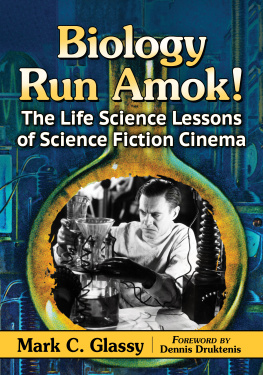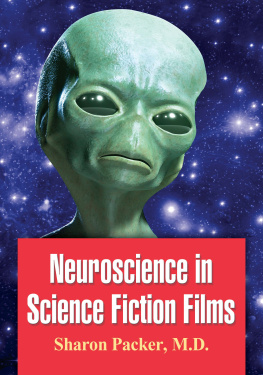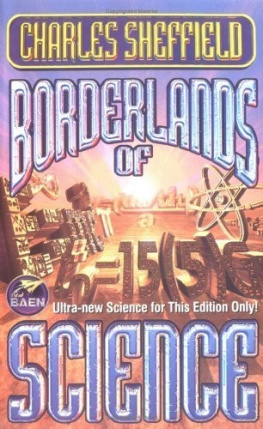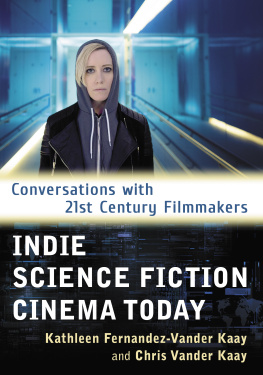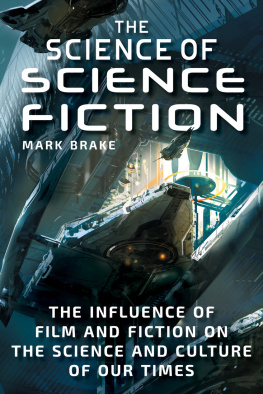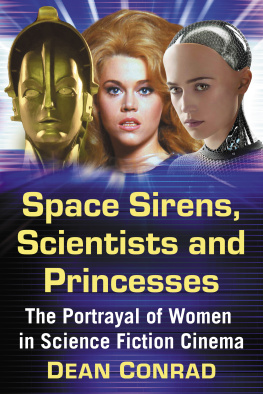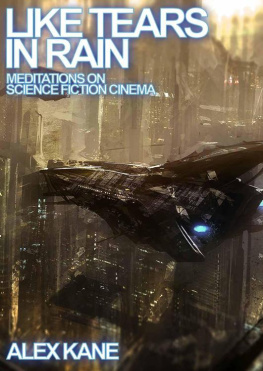Glassy - Biology run amok!: the life science lessons of science fiction cinema
Here you can read online Glassy - Biology run amok!: the life science lessons of science fiction cinema full text of the book (entire story) in english for free. Download pdf and epub, get meaning, cover and reviews about this ebook. City: Jefferson, year: 2018, publisher: McFarland & Co, North Carolina, genre: Home and family. Description of the work, (preface) as well as reviews are available. Best literature library LitArk.com created for fans of good reading and offers a wide selection of genres:
Romance novel
Science fiction
Adventure
Detective
Science
History
Home and family
Prose
Art
Politics
Computer
Non-fiction
Religion
Business
Children
Humor
Choose a favorite category and find really read worthwhile books. Enjoy immersion in the world of imagination, feel the emotions of the characters or learn something new for yourself, make an fascinating discovery.
- Book:Biology run amok!: the life science lessons of science fiction cinema
- Author:
- Publisher:McFarland & Co, North Carolina
- Genre:
- Year:2018
- City:Jefferson
- Rating:3 / 5
- Favourites:Add to favourites
- Your mark:
- 60
- 1
- 2
- 3
- 4
- 5
Biology run amok!: the life science lessons of science fiction cinema: summary, description and annotation
We offer to read an annotation, description, summary or preface (depends on what the author of the book "Biology run amok!: the life science lessons of science fiction cinema" wrote himself). If you haven't found the necessary information about the book — write in the comments, we will try to find it.
Glassy: author's other books
Who wrote Biology run amok!: the life science lessons of science fiction cinema? Find out the surname, the name of the author of the book and a list of all author's works by series.
Biology run amok!: the life science lessons of science fiction cinema — read online for free the complete book (whole text) full work
Below is the text of the book, divided by pages. System saving the place of the last page read, allows you to conveniently read the book "Biology run amok!: the life science lessons of science fiction cinema" online for free, without having to search again every time where you left off. Put a bookmark, and you can go to the page where you finished reading at any time.
Font size:
Interval:
Bookmark:

Also by MARK C. GLASSY
Movie Monsters in Scale: A Modelers Gallery of Science Fiction and Horror Figures and Dioramas (McFarland, 2013)
The Biology of Science Fiction Cinema (McFarland, 2001; softcover 2006)
Foreword by Dennis Druktenis

McFarland & Company, Inc., Publishers
Jefferson, North Carolina
LIBRARY OF CONGRESS CATALOGUING DATA ARE AVAILABLE
BRITISH LIBRARY CATALOGUING DATA ARE AVAILABLE
e-ISBN: 978-1-4766-2592-8
2018 Mark C. Glassy. All rights reserved
No part of this book may be reproduced or transmitted in any form or by any means, electronic or mechanical, including photocopying or recording, or by any information storage and retrieval system, without permission in writing from the publisher.
On the cover: The Bride of Frankenstein, 1935 (Universal Pictures/Photofest); background Laboratory 2018 CSA-Images/iStock
McFarland & Company, Inc., Publishers
Box 611, Jefferson, North Carolina 28640
www.mcfarlandpub.com
For Donna
my wife, my life
by Dennis Druktenis
Mark C. Glassys first article for Scary Monsters Magazine appeared in 2009 in our Scary Monsters 2009 Yearbook, Monster Memories, #17. I figured why make Marks Scary writing debut start with only one article and why not feature two, so not one but two articles were featured in MM #17. The Scary Monsters 2009 Yearbook was quick to sell out for many scientific reasons (supply and demand?), but perhaps it was because of Marks two debut articles! So you better quickly purchase not one but two copies of this book before it sells out. You can save both or perhaps give one to a friend.
Mark became a regular writer a few issues later with Scary Monsters issue #72 in 2009.
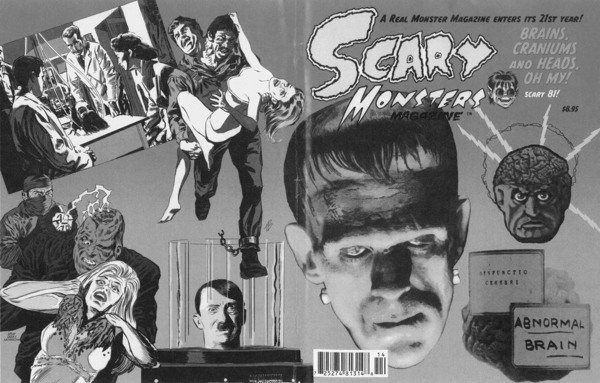
Cover toScary Monsters#81 featuring the article Brains, Craniums, and Heads, Oh My! 2016 Dennis Druktenis Publishing & Mail Order, Inc.
A number of his pieces over the years have been Rondo Award nominees for Best Article.
It never ceases to amaze me that monster movies fans from around the country, and even the world, share many of the same Monster Memories, which turned them into the fans they are today. Perhaps Dr. Glassy can explain all this in more scientific terms. Actually, he did tackle that very topic back in Scary Monsters #81, 2012, with Brains, Craniums, and Heads, Oh My!
From 2009, Scary Monster readers had a nonstop fun learning experience compliments of Mark all the way through issue #99 in 2015. Now these articles are gathered together, so everyone can enjoy them all in a single tome.
Submitted for your approval is the Skinny on all things Scary. Enjoy!
Dennis J. Druktenis is the publisher, editor-in-chief and creator of Scary Monsters Magazine.
Film is a powerful tool for teaching. After all, the most dominant art form is film and more people see film than all other forms of art or entertainment combined. As such, movies have had a significant influence on the general public and have sparked many popular trends. Also, films are an excellent yard stick in which to measure the sign of the times since each film is forever locked into its view of the world at the time of its making. With the popularity of film it is no surprise that movies can also be used as a means to teach and educate the public. For many, much of the big picture of science has been obtained from popular media. The first time people saw a skeleton or a human brain was either in a film or a cartoon, often years before a classroom setting was involved. These images have significant impacts on young impressionable minds.
The current generation, one I think could be called the Jurassic Park Generation, has primarily obtained their science from popular culture and media. How many people out there really think that dinosaurs can be cloned from surviving cells in insects encased in amber? Film does influence and often times the pseudo-science presented in science fiction (SF) films affects the decision making of people, oftentimes thinking that what they see on the screen is factual. Whether consciously or subconsciously film does make an impact. One of the goals of writing the essays assembled in this book is to help the reader better understand the difference between science and pseudo-science as a presented in SF films. This is important as more and more of the audience becomes familiar with basic science principles and their applications.
After all, even the acronym, DNA is being used in standard television, radio, and print commercials (its in our DNA) so the general population does understand the concept of DNA and that these three capitalized letters somehow, magically, control our lives. DNA is the universal genetic language for all species from unicellular bacteria all the way up to humans and everything in between. (And since there is yet no definite proof of extraterrestrialsso this is therefore speculationI am quite willing to predict that, when we find it [or it finds us], life out there is also based on DNA.)
For this particular book the films of interest are SF films. Though obvious, a key word in science fiction is science which is something each films brain trust (writer, producer, director) can take at face value, twist in novel ways, completely ignore, or completely make out of whole cloth. This is OK and is highly dependent upon the script and, of course, the budget. The other obvious key word in SF is fiction meaning going anywhere and everywhere so anything can, and probably will, happen. The chapters in this book are not intended as criticism but rather an embracing of the genre, looking at both the science and the fiction in SF cinema, as a teaching tool.
Professionally, I am a cancer immunologist. As a faculty member at the University of California, San Diego (UCSD) I taught a class on antibodies, proteins of the immune system. Though I enjoyed teaching very much over the years I never had any more than 25 students in each class. In having a positive teaching experience at UCSD, I kept thinking what it would be like to have a class of hundreds, perhaps thousands, maybe even 10,000 students. A problem that could be solved through writing.
One of the reasons for writing these essays was to engage the general public in a discourse on science (the teacher in me). Most people (some estimated 95 percent) get their science outside of the classroom and, unfortunately, not all of it is accurate, and SF films do play a part in this. This is the above referenced, Jurassic Park Generation, who get most of their science from popular media. Hopefully, this book will help them understand and appreciate science more clearly. This could raise the collective civic science literacy of the general public and certainly enrich their lives. In essence, raise societys science IQ. By raising this collective bar the general public may be better informed in future decision making, job skills, and an overall general higher standard of intellectual living. Current issues such as global warming, stem cells, ozone hole, artificial life, biosensors, and cloning will be essential elements of future life and with an elevated sense of science literacy the general public will be better served and be able to make intelligent decisions.
Next pageFont size:
Interval:
Bookmark:
Similar books «Biology run amok!: the life science lessons of science fiction cinema»
Look at similar books to Biology run amok!: the life science lessons of science fiction cinema. We have selected literature similar in name and meaning in the hope of providing readers with more options to find new, interesting, not yet read works.
Discussion, reviews of the book Biology run amok!: the life science lessons of science fiction cinema and just readers' own opinions. Leave your comments, write what you think about the work, its meaning or the main characters. Specify what exactly you liked and what you didn't like, and why you think so.

